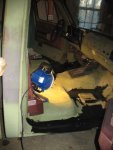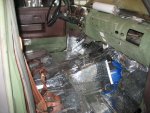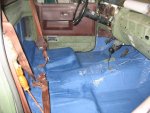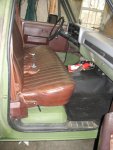What Josh says is correct, I used this site a lot for researching the how to aspects. https://www.sounddeadenershowdown.com/ He sells the materials as well. I primarily used bedliner to seal the metal, I used spray lining.com for my bedliner and used the coarse mix to replicate Line X. I had already wire brushed, welded patches as needed, phosphate prepped and used 2 part epoxy primer. I do believe it will result in greater stiffness and a less tinny sound. MLV it seems can be replaced by lead, does the same job and MLV is also not light, mostly I wanted to avoid any spongy materials that cold hold water to the floor, but I feel the metal is well sealed.
-
Steel Soldiers now has a few new forums, read more about it at: New Munitions Forums!
Sound proofing, is it worth the money and time?
- Thread starter 86M10086.2L
- Start date

More options
Who Replied?JoshHefnerX
New member
- 52
- 2
- 0
- Location
- Glendale, AZ
Closed cell foam will not retain water like open-cell foam does. Open cell foam is like the sponge on your sink, vs neoprene like wetsuit material.
JoshHefnerX
New member
- 52
- 2
- 0
- Location
- Glendale, AZ
That lead will make a good barrier. Heavier the better. Not sure where you get lead sheeting from nowadays...
I ordered it from rotometals.com, it was 40lbs for a 40 sq ft roll. I got the idea from reading several places that MLV "was as effective as lead", made me think why not just use lead. The local roofing supply house had it too but only in bigger rolls than I could ever need, it is available but not at the big chains.
- 540
- 22
- 18
- Location
- Greenville SC
I agree with Josh. You can get the right foam / vinyl product and you will get a 5 db drop instantly. I worked on a diesel conversion and using second skin products in a land rover really made a difference. It was worth the time, effort and expense and we got a 17 db drop in the cab. That was a lot!
87J
Member
- 38
- 1
- 6
- Location
- Conklin, MI
In my opinion its worth it, but I only did the cab of my m1010, used dyanmat extreme in the doors and lined the cab floor with mega mat then covered it with the LMC rubber floor. I wouldn't spend the extra money on the dynamat again, the mega mat appeared to be the same thickness and material for less than half the price. I was also told the under hood insulation makes the biggest difference, that's on my list upgrades.
- 2,011
- 76
- 48
- Location
- Orlando, FL
Go to a place that sells RV's. Go to the parts department. Buy a tube of caulk that's used for the windshields of $500,000 Class A's. Take the wipers off, and take the metal screen off of the truck. Re-caulk the body seams inside the cowl box on a day with no chance of rain.
I have been soundproofing mine even though the extent of my sound system will be a cb radio with weatherband. I sprayed in a bedliner after thoroughly de rusting and repairing my floor pans. I have replaced all seals including on the fiberglass top and I am almost leak free, I have a leak from somewhere under the cowl that lets in about a tablespoon in a major down pour and I get a few tablespoons in from a back glass seal.
Vaughjw
New member
- 10
- 0
- 1
- Location
- Azle, Texas
I shot 2 gallons of OD Green Durabak in the cab of our M35A2, worth every penny.
I can actually talk to a passenger while were doing 55 now.
I can actually talk to a passenger while were doing 55 now.
sully199
Member
- 170
- 7
- 18
- Location
- coral springs Fl
What I did in my HMMWv, I bought some sound reducing material from a marine supply store, its for use in diesel engine compartments on boats, it took away 85% of the noise, I can talk on my phone, talk to the kids etc,Plain and simple as the title implies. For those who have done it or know someone who has. Was the expense/effort required in sound insulating a M1009 worth it in the end? I know how I can do it. Carpeting, dynomat or the like, bed liner etc... But did it do enough? I'm not looking to reinvent the wheel here. I knew what this truck was when I got it. And what it will never be. That's the main reason I got it. If I wanted a modern, soft SUV I would have bought one. I just want to take the edge off, have a conversation and have the recipient hear me without yelling. Maybe even listen to music or the radio without the volume all the way up.
tim292stro
Well-known member
- 2,117
- 40
- 48
- Location
- S.F. Bay Area/California
Just about any Butyl Rubber Sealant will do. Butyl rubber stays flexible for decades so it doesn't crack or tear like a latex calk. When I do anything weather expose to a structure or vehicle, I think about how the rain can get in, seal the drip and splash points and provide a surface tension break for spaces where capillary action can suck water into a space (between materials or walls). GM didn't do a great job thinking about this on the "new-look" and "square-body" trucks. Why would they put a body panel joint in the bottom corners of the mostly square shaped windshield? By the way, square joints are the hardest type to seal, which is why hydraulic cylinders are round at the sealGo to a place that sells RV's. Go to the parts department. Buy a tube of caulk that's used for the windshields of $500,000 Class A's. Take the wipers off, and take the metal screen off of the truck. Re-caulk the body seams inside the cowl box on a day with no chance of rain.
Leaks aren't a big problem unless there was nowhere for the water to go, or no opportunity for the water to dry/evaporate. If you use foam, make sure it's closed-cell type so that it doesn't suck in water and hold it. If you expect water is going to get under your carpet or padding, give it somewhere to drain or allow/force air to circulate and it'll dry out.
It's not just the mass of an object that determines its sound attenuation capabilities, it's the characteristics of the structure it is a component of. It takes energy to make and object move, increasing its mass increases the amount of energy required to move the object a given distance. If the object is decoupled from a structure (allowed to move independent of the structure), the energy imparted to that object will affect the object only as it is allowed to move separately from the rest of its structure.
Think of this now in a vehicle - what assemblies have devices which decouple an object from the rest of the structure?
- The most obvious is the suspension. If the axles were hard-bolted straight to the frame, you'd feel every pebble you ran over and every bump would be that much worse.
- Engine has engine mounts as well as hoses and wires which are flexible so that they decouple the movement of the engine from the chassis. If you replaced the soft engine mounts with hard metal brackets, all of the vibrations created by the engine would end up in the rest of the chassis.
- Body has body mounts as well as again hoses and wire which are flexible, and mechanical joints on steering and shift linkages which allow decoupling of the body movement from the frame. If you replace the bode mounts with hard welds, the whole body will contain the vibrations that the frame had
- Seat has internal suspension which keeps most of what is left in body vibrations out of your butt.

What an underhood blanket is doing to kill sound is becoming the first thing that a soundwave has to move in order to be transmitted into a body panel - if it is decoupled from the body the energy that the blanket absorbs goes into only moving the blanket and not the body panel, so no (or maybe just less) sound energy vibrates the body panel. That's less energy further down the transmission path on its way to your body and ears to feel.
Now think about the body panel - does it generate noise? No, but it is moved by noise generated from something else. So what is the bedliner doing? It's adding mass to the panel, which increases the energy required to move it. One's expectation should not be that a dynamat or bedliner application is going to kill all of the noise as it is very tightly coupled with the body panel itself if the panel moves the dynamat/bedliner will move with it - there will be something with enough acoustic energy (mechanical structure-borne noise or air vibrations as sound), to move that body panel. The dynamat and bedliner don't prevent the transmission of sound, isolators/dampeners do.
By having a carpet on a foam which decouples the carpet from the floorboard, the carpet can move independently from the floor board so if the floorboard moves it doesn't necessarily move the carpet layer. Under the hood a blanket might move but it doesn't necessarily move the body panel behind it. This is why decoupling is good for preventing acoustic energy TRANSMISSION. It should be said that if you are in the space where sound is, there are no barriers which would make dampening effective at reducing noise - in that cases absorption ("eating" energy) to prevent any reflection, and diffraction/diffusing or breaking up a reflection into many reflections, makes the reflection less harmful to what you want to hear.
This is one of the reasons I advocate for first finding out what sources of objectionable noise you are dealing with are, then attempting to kill the noise as close to the source as possible where it's most practical and cost effective - and likewise, you don't want to harm the "good sound" (like from your stereo) by over-treating the interior. Like was said in War Games "The only way to win [Global Thermonuclear War], is not to play." Making sure that there is no noise to get to a body panel is what keeps you from having that fight at the body panel - keep the bad sound out of the inside of your truck or from getting to the walls of your truck, and you'll have less to do inside the truck for stereo audio to be of good quality.
honda
Member
- 52
- -1
- 6
- Location
- Southern Arizona
Sprayed 2 layers of lizard skin sound control on the floor and up the sides and firewall followed by 2 layers of lizard skin ceramic. Did the same trick on the interior metal roof skin and topper interior. Lizard skin is very easy to apply, sticks really well and when properly applied can be comfortably coated with Line-X. Make sure you buy the lizard skin application gun. Ask me how I know? Prep is important. Did I say important? My unit was cleaned to bare metal, rust bullet where necessary and then U-POL 20:25 primer coated followed by the top coatings. I don't want any more rust than necessary and I wanted the sound abatement to stick forever. Lizard skin drys black and sticks to virtually anything and everything, if prep is done well. Then applied Line-X ( tinted CARC green - very cool ) on the floor, up the sides and interior firewall - not the roof. Don't forget to spray lizard skin and Line-X on the tailgate interior. Made a Huge difference in heat control and sound abatement. This is a desert truck. Very hot.
Before applying the coatings all weathertight seal tolerances were considered. Some body work was done so the seals would work and keep out not only noise but also diesel fumes, especially from the back, in and around the tail gate. Also, do a night time light test, looking for unexpected holes in the skin and seals. Seal the holes. Weld or otherwise, but get them sealed. It's amazing how many penetrations in the exterior skin, including stress cracks, can be found in the firewall and the floor.
Next - installed a hood blanket from LMC. This also made a significant difference in engine noise . Dynamat extreme inside the front doors and lots of it. Several 2'x2' or a bit smaller pieces of acoustic sound dampening foam [ egg crate looking stuff ] up against the sides in the back and under the seats.
Standard 6 inch speakers in the front door kick panels ( down low ) with sound baffles behind the speakers, and two wave boat speakers hung from the rear roll cage provide excellent fidelity for Sirius/XM [ channels 16-30 ] The louder the better. I can easily carry on a normal conversation on the cell, radios, with a passenger or the local DPS LEO who likes to stop and talk. It's always show and tell time with him.
The only thing I might yet do is spray lizard skin sound control in the wheel wells for road noise abatement. Problem is, I don't want it too quite. I rather like the sound of those kevlar tires flying down the road. Just a wild thought from my diseased brain.
Most of this stuff can be done in your garage, except for Line-X which is dealer supplied and applied.
What ever works. Lots of good ideas in this thread. Most of the ideas for my truck are straight out of SS. Thanks guys.
Carry on.
Before applying the coatings all weathertight seal tolerances were considered. Some body work was done so the seals would work and keep out not only noise but also diesel fumes, especially from the back, in and around the tail gate. Also, do a night time light test, looking for unexpected holes in the skin and seals. Seal the holes. Weld or otherwise, but get them sealed. It's amazing how many penetrations in the exterior skin, including stress cracks, can be found in the firewall and the floor.
Next - installed a hood blanket from LMC. This also made a significant difference in engine noise . Dynamat extreme inside the front doors and lots of it. Several 2'x2' or a bit smaller pieces of acoustic sound dampening foam [ egg crate looking stuff ] up against the sides in the back and under the seats.
Standard 6 inch speakers in the front door kick panels ( down low ) with sound baffles behind the speakers, and two wave boat speakers hung from the rear roll cage provide excellent fidelity for Sirius/XM [ channels 16-30 ] The louder the better. I can easily carry on a normal conversation on the cell, radios, with a passenger or the local DPS LEO who likes to stop and talk. It's always show and tell time with him.
The only thing I might yet do is spray lizard skin sound control in the wheel wells for road noise abatement. Problem is, I don't want it too quite. I rather like the sound of those kevlar tires flying down the road. Just a wild thought from my diseased brain.
Most of this stuff can be done in your garage, except for Line-X which is dealer supplied and applied.
What ever works. Lots of good ideas in this thread. Most of the ideas for my truck are straight out of SS. Thanks guys.
Carry on.
Another Ahab
Well-known member
- 18,143
- 4,955
- 113
- Location
- Alexandria, VA
Hey, honda, welcome to the rodeo.
joshuak
Active member
- 747
- 216
- 43
- Location
- Slower shore, DE
x2.Hey, honda, welcome to the rodeo.
...and some pics of your rig would be great. Sounds like you've put some time in her, pun not intended.
dependable
Well-known member
- 1,720
- 188
- 63
- Location
- Tisbury, Massachusetts
Some file photos of soundeadening from some of the many older threads on the subject:
I take the seat out, wash the crud off the floor & fix any rust and treat with rust inhibitor,
Next I put down Rammat, like Dynamat, then paint with Lizard skin & paint with CARC substiute.
Finish off with OEM style rubber mat with no water holding insulation underneath.
I think it is worth it, you can still tell it is a diesel, but is a lower tone and a little less grading.
Good time to replace door seals.
I take the seat out, wash the crud off the floor & fix any rust and treat with rust inhibitor,
Next I put down Rammat, like Dynamat, then paint with Lizard skin & paint with CARC substiute.
Finish off with OEM style rubber mat with no water holding insulation underneath.
I think it is worth it, you can still tell it is a diesel, but is a lower tone and a little less grading.
Good time to replace door seals.
Attachments
-
99.9 KB Views: 68
-
89.5 KB Views: 71
-
61.4 KB Views: 68
-
59.1 KB Views: 66
87J
Member
- 38
- 1
- 6
- Location
- Conklin, MI
Not sure if the military used them but I installed an intake silencer off a civilian 6.2. Unbelievable difference in resonance throughout the cab!
MarcusOReallyus
Well-known member
- 4,524
- 820
- 113
- Location
- Virginia
Interesting. I'm not familiar with that. Where did you get that beast?
tim292stro
Well-known member
- 2,117
- 40
- 48
- Location
- S.F. Bay Area/California
I bought an intake silencer and the OEM GM plumbing for it, but I'm going to pick up a civilian air-filter housing to wrap in dynamat and an acoustic blanket first. That gets the "ping" out of the air filter housing, covers the injector lines, and gives a place to put a pair of valve cover blankets too. Some deadening on the oil pan, and some dampening on the timing chain cover takes care of most of the resonating surfaces on the engine itself. With good flexible engine and transmission mounts, most of the vibration from the engine is absorbed. Then blankets on the hood, firewall and inner fenders will absorb a good chunk of the airborne sound inside the engine compartment.
Last edited:
cucvrus
Well-known member
- 11,478
- 10,505
- 113
- Location
- Jonestown Pennsylvania
Low Income Red Neck Sound proofing. It will work everytime.
 Application instructions. Find a nice logging trail and a farm field that has semi dry sticky mud and water. Drive briskly thru the mud and spin hard in the wet mud and water. Drive thru chopped corn fodder and hit the mud again to pack it in real good. Let dry for a few hours.
Application instructions. Find a nice logging trail and a farm field that has semi dry sticky mud and water. Drive briskly thru the mud and spin hard in the wet mud and water. Drive thru chopped corn fodder and hit the mud again to pack it in real good. Let dry for a few hours.
You will swear it is not the same vehicle you drove out to cut wood in. My Sony sounded better after the 8 hours in the mud. I even drove thru the city and got many more thumbs up then usual. Must have been the sound proofing.
 Application instructions. Find a nice logging trail and a farm field that has semi dry sticky mud and water. Drive briskly thru the mud and spin hard in the wet mud and water. Drive thru chopped corn fodder and hit the mud again to pack it in real good. Let dry for a few hours.
Application instructions. Find a nice logging trail and a farm field that has semi dry sticky mud and water. Drive briskly thru the mud and spin hard in the wet mud and water. Drive thru chopped corn fodder and hit the mud again to pack it in real good. Let dry for a few hours. You will swear it is not the same vehicle you drove out to cut wood in. My Sony sounded better after the 8 hours in the mud. I even drove thru the city and got many more thumbs up then usual. Must have been the sound proofing.
tim292stro
Well-known member
- 2,117
- 40
- 48
- Location
- S.F. Bay Area/California
You can find them in junkyards or eplace. The silencer is called a resonator in parts manuals.Interesting. I'm not familiar with that. Where did you get that beast?
MarcusOReallyus
Well-known member
- 4,524
- 820
- 113
- Location
- Virginia
View attachment 611954application instructions. Find a nice logging trail and a farm field that has semi dry sticky mud and water. Drive briskly thru the mud and spin hard in the wet mud and water. Drive thru chopped corn fodder and hit the mud again to pack it in real good. Let dry for a few hours.
You will swear it is not the same vehicle you drove out to cut wood in. My sony sounded better after the 8 hours in the mud. I even drove thru the city and got many more thumbs up then usual. Must have been the sound proofing.

- 114,343members
- 167,221threads
- 2,354,162posts
- 3,024online users




